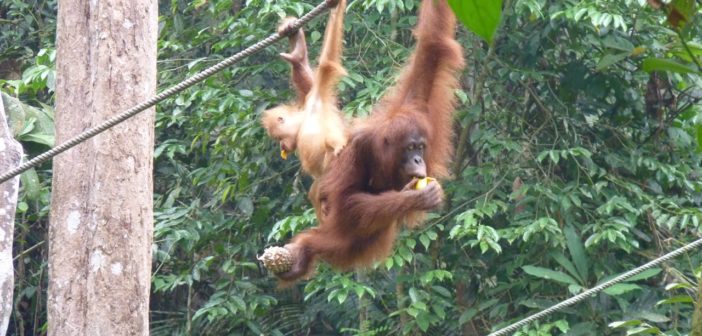It’s International Orangutan Day today and events have been organised around the world to raise awareness about the plight of the now critically endangered primate, whose DNA is 97 percent the same as humans.
In 2016, the International Union for Conservation of Nature (IUCN) changed the classification of the Bornean orangutan (Pongo pygmaeus) from endangered to critically endangered, citing the main causes of its population decline as habitat loss and fragmentation, primarily for logging and oil palm plantations, along with illegal hunting and fires.
The Sumatran orangutan (Pongo abelii) is also listed as critically endangered. There are now only about 14,600 left in the wild.
There are estimated to be between 55,000 and 62,000 Bornean orangutans living in the wild, split into three distinct subspecies.
The IUCN says the population trend is a decrease for both species.
Orangutans’ solitary nature and slow reproductive rates leave them particularly vulnerable when there is forest loss. The rate of population decline is such that it is difficult for the populations to recover because of the lengthy birth intervals.
In findings published in Nature Research’s Scientific Reports in July this year, a group of researchers concluded that Bornean orangutan populations had declined by 25 percent over the past decade.
The researchers estimated that the overall density of orangutans on the island of Borneo from 1997-2002 was about 15 individuals per 100 square kilometres. The density was reduced to 10 individuals per 100 square kilometres in 2009–2015.
The scientists point to the difficulty of accurately assessing the rate of population decline.
“Despite strong public and scientific interest in orangutans, in addition to considerable efforts and spending to conserve the species, we do not have an accurate assessment of the rate of Bornean orangutan population decline, or the drivers of this decline.
“Over the years, different estimates of population sizes have been proposed by various authors, leading to confusion about the conservation status of the species.”
The rate of decline and the drivers of the population change of orangutans are difficult to assess because of the species’ cryptic behaviour, and because surveys of orangutans are typically restricted to small geographic areas, are conducted over short time periods and employ different survey protocols, the researchers say.
A recent report published by the International Institute for Environmental Development (IIED) says the development of large-scale oil palm plantations is responsible for significant loss and degradation of orangutan habitat in Borneo.
One of the main reasons for the population decline is that the Bornean orangutan’s preferred habitat – tropical lowland and peatland rainforests – is largely the same as that targeted for agricultural development, the IIED report states.
“The rapid expansion of the oil palm industry – particularly large-scale plantations, but also government-mandated smallholder schemes – is thus one of the main causes of the loss and degradation of orangutan habitat in Borneo.”
As of 2010, at least 18 percent of remaining orangutan habitat in Borneo was located within large-scale oil palm estates that have not yet been fully ‘developed’, the IIED report says.
The IIED report says that, as a result of habitat loss and hunting, it is expected that, by 2025, the orangutan population in Borneo will decline by 86 per cent as compared to its size in 1973.
“Many populations are expected to be lost if current threats are not abated.”
Ways of securing the survival of orangutans in such areas must be identified as an urgent priority, the authors say. “If nothing is done, most will be gone in the next ten years.”
Orangutans are protected under Indonesian and Malaysian legislation, but law enforcement has proved grossly inadequate, the IIED report’s authors state.
“In addition, state-protected areas cover just 25 per cent of remaining orangutan habitat in Borneo. Both species- and area-based legal protections are thus insufficient for the long-term survival of orangutans.”
This is an extract from Annette Gartland’s article on Changing Times. You can read the full story about the plight of the primates who are now critically endangered, and the work of those battling to rescue and protect them, at https://time2transcend.wordpress.com/2017/08/19/world-orangutan-day-conservationists-call-for-an-end-to-habitat-destruction/
Featured image: rehabilitated mother orangutan and baby at a feeding station at Semenggoh Wildlife Centre outside Kuching, Malaysia on the island of Borneo. Courtesy Wolf Gordon Clifton / Animal People, Inc.





